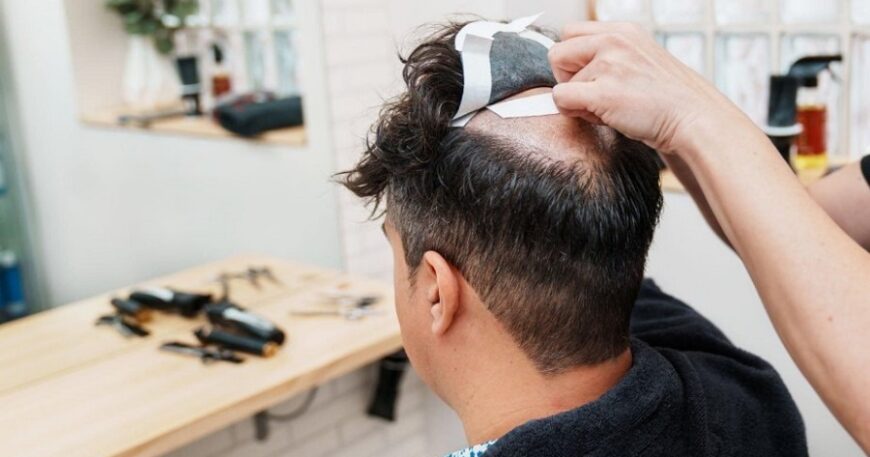What is the Difference Between Hair Patch & Hair Wigs?
Hair loss affects millions of people worldwide, and solutions like hair patches and wigs offer a way to regain confidence. While both aim to improve appearance, they serve different purposes and cater to unique needs. Let’s dive into what sets them apart.
What is a Hair Patch?
A hair patch is a custom-made hairpiece designed to cover specific bald spots or thinning areas on the scalp. Made from either synthetic or natural hair, it is usually attached using adhesives or clips to blend seamlessly with existing hair.
How it works:
Hair patches are fixed to the scalp, offering a secure and natural look. They’re ideal for individuals with partial baldness, such as those experiencing hair loss due to alopecia or other medical conditions.

What is a Hair Wig?
A hair wig is a complete hair covering designed to replace or enhance a full head of hair. Wigs can be made from synthetic fibers or natural human hair, and they come in various styles, lengths, and colors.
Types of wigs:
- Synthetic wigs: Affordable and easy to maintain but less natural-looking.
- Human hair wigs: More realistic and versatile but require extra care.
How it works:
Wigs are worn over the scalp, either with an elastic cap or clips. They’re a go-to option for individuals experiencing complete hair loss or those seeking quick style changes.

Key Differences Between Hair Patch and Hair Wigs
Design and Attachment
- Hair Patch: Fixed using adhesives or clips; semi-permanent.
- Hair Wig: Removable and worn as needed.
Coverage Area
- Hair Patch: Covers specific bald areas.
- Hair Wig: Provides full scalp coverage.
Customization
- Hair Patch: Custom-made for a perfect match.
- Hair Wig: Often pre-designed but can be tailored.
Comfort and Fit
- Hair Patch: Lightweight and snug for localized areas.
- Hair Wig: Bulkier but offers full coverage.
Durability
- Hair Patch: Can last 6 months to 2 years with proper care.
- Hair Wig: Lasts a few months to a year, depending on material quality.
Cost
- Hair Patch: Generally more expensive due to customization.
- Hair Wig: Budget-friendly options available, especially in synthetic variants.
Pros and Cons of Hair Patches
Pros
- Natural appearance for partial hair loss.
- Lightweight and breathable.
- Can be styled like natural hair.
Cons
- Requires maintenance for adhesives.
- Not suitable for complete baldness.
Pros and Cons of Hair Wigs
Advantages
- Instant full coverage.
- Easy to wear and remove.
- Affordable options available.
Disadvantages
- May feel bulky.
- Can be less secure during vigorous activities.
How to Choose Between Hair Patches and Wigs
When deciding, consider the extent of hair loss, lifestyle needs, and budget. A hair patch is better for partial baldness, while wigs are ideal for complete coverage or temporary use.
Maintenance and Care Tips
- Cleaning: Use gentle shampoos for both patches and wigs.
- Storage: Keep them on a stand or in a case to maintain their shape.
- Styling: Avoid excessive heat on synthetic materials.
Myths About Hair Patches and Wigs
- “They don’t look natural.” Advanced designs ensure a realistic look.
- “They’re uncomfortable to wear.” Proper fitting eliminates discomfort.
Who Should Consider Hair Patches or Wigs?
Both options suit individuals experiencing hair loss due to genetics, medical treatments, or hormonal changes. Choose based on the coverage and lifestyle preferences.
Conclusion
Hair patches and wigs offer versatile solutions for hair loss, each with distinct benefits. Understanding the differences can help you make an informed choice tailored to your needs.
FAQs
- Can I swim or exercise with a hair patch or wig?
Yes, but ensure the attachment method is secure. - How long does a hair patch or wig last?
Hair patches last 6 months to 2 years; wigs last 6-12 months. - Is a hair patch suitable for complete baldness?
No, it’s designed for partial coverage. Wigs are better for full coverage. - Are hair patches and wigs safe for sensitive scalps?
Yes, but choose hypoallergenic materials if you have a sensitive scalp. - How often should they be replaced?
Replacement depends on usage and maintenance—usually every 6-12 months.




